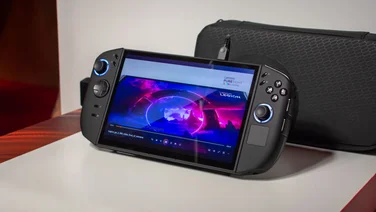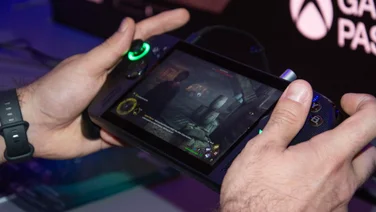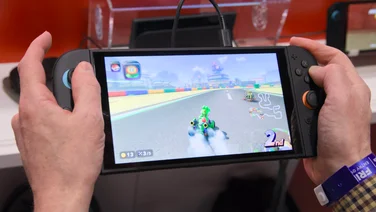To help us provide you with free impartial advice, we may earn a commission if you buy through links on our site. Learn more

- The best room-scale VR experience available
- HTC is investing in the Vive ecosystem
- Can be used either seated or standing
- Most expensive headset on the market
- Still aren't quite enough killer apps out there
- So. Many. Cables.
Update: HTC Vive now only £400
The HTC Vive is now the cheapest it’s ever been, and it’s starting to look like it will stay that way. Along with the announcement that the HTC Vive Pro (a souped-up version of the HTC Vive) will launch in the UK on 5 April and cost a whopping £799, HTC Vive has slashed the price of its original VR headset to just £400. Permanently.
In an effort, I imagine, to bring their headset in line with the Oculus Rift’s £400 price tag, the company has made its first, tentative, steps at bringing VR to the masses. Of course, unlike Microsoft Mixed Reality headsets, you still need a pretty beefy PC to take full advantage of the Vive’s VR capabilities.
Vaughn’s HTC Vive review continues below.
HTC Vive review
The HTC Vive launched almost a year ago and, in that timeframe, much has changed within the VR market. Sony has taken the crown with its PlayStation VR, with sales reaching almost one million units in just over four months; Oculus Rift has now brought out its hand-tracked controllers, slashed its price and opened itself up to the potential of room-scale VR; mobile VR has seen vast improvements thanks to Google Daydream and a redesigned Samsung Gear VR; and with Resident Evil 7, VR games are finally starting to creep into the mainstream.
So where does this leave the HTC Vive? On the surface, not an awful lot has changed for HTC’s headset. The unit you’ll go out and buy has actually gone up in price since launch, largely thanks to Brexit and the decline of the pound – the contents of the box you buy hasn’t changed. Sure, new and exciting Vive projects are on the way in the form of a new “Deluxe Head Strap” and the developer-only object tracker, but one’s still a long way off from reaching consumers and the other is just a new head strap.
Despite all those negatives, I still believe the HTC Vive is the best way to experience VR right out of the box.

HTC Vive review: System requirements
The experience of using a HTC Vive is genuinely wonderful but, to do so, you’ll need a beast of a PC. However, thanks to Nvidia and AMD launching new cards, the cost of acquiring a PC that meets HTC Vive’s recommended specs has dropped somewhat since launch. We’re not talking about a £300-400 PC yet, but you should be able to put one together for around £700 instead of closer to £1,000.
Here’s what you’ll need as an absolute minimum to get Vive going:
|
Minimum requirements |
|
|
CPU |
Intel Core i5-4590 / AMD FX-8350 |
|
GPU |
Nvidia GeForce GTX 970 / AMD Radeon R9 290 |
|
RAM |
4GB |
|
Connections |
HDMI 1.4 / DisplayPort 1.2 2 x USB 2 1 x USB 3 |
|
Operating system |
Windows 10 / 8.1 / 7 SP3 |
HTC Vive review: Specs and setup
Comparing the HTC Vive’s specs against those of the PlayStation VR, you’ll see that HTC’s headset blows the PSVR out of the water in terms of raw numbers. Compared to Oculus Rift, however, they’re practically identical on paper. Both have 2,160 x 1,200 panels shared across each eye with 110 degrees of view and 90Hz refresh rate, but they aren’t built alike.

|
Oculus Rift |
HTC Vive |
|
|
Display (in pixels) |
2,160 x 1,200 |
2,160 x 1,200 |
|
Field of view |
110 degrees |
110 degrees |
|
Refresh rate |
90Hz |
90Hz |
|
Weight |
470g |
555g |
|
Tracking area |
5 x 11ft |
15 x 15ft |
|
Controllers |
Xbox One pad / Oculus Touch |
2 x Vive baton controller / Steam Controller / Any PC-enabled controller |
|
Audio |
Integrated headphones |
N/A |
|
Connectivity |
HDMI 1.3 USB 3 USB 2 |
HDMI 1.4 USB 2 |
|
OS |
Windows |
Windows OS X Linux |
The Vive’s screen tends to appear brighter and sharper than that of the Oculus Rift, and its design is also friendlier to those with glasses – although it really depends on your glasses. Because of this, the HTC Vive feels nicer to use for longer periods of time. Its wand-like controllers are also incredibly accurate and – while I’ll admit I’ve only spent a short while with Oculus Touch – seem to be more accurate and cut out less often than Rift’s Touch controllers.
In regards to the HTC Vive setup process, it’s all rather straightforward, despite the mountains of cables and peripherals that need to be hooked up. Before you start unpacking your Vive’s various components, you need to make sure you’ve got enough space available to play in. Unless you’re planning to play your Vive seated, you need to make sure there’s at least 2 x 3m space for you to stand up in – ideally you’ll want the maximum 4 x 4m space to play within, though. You also need to place both sensors at least 2m off the ground.
Once that’s done, the included setup instructions and the digital tutorial found in the Vive software actually makes the whole process rather straightforward. In fact, during our testing, the hardest part was finding a room big enough for us to use. We also had issues finding a surface high enough to place the HTC Vive’s lighthouse beacons, but thankfully HTC has included wall mounts, so that will be less of an issue for those installing it permanently into their homes.

The mountain of cables isn’t so bad once out of the box, either. While you can connect sensors together with a wire, the beacons sync wirelessly so won’t be needed when you’re playing. The 3m cable from the HTC Vive headset to your computer is also rather compact and goes via a small breakout box to keep it a little tidier. Other than that, you’ll just have the power cables for both beacons and the headset, and the USB to micro-USB plugs for each Vive controller.
All in all, the setup process takes around an hour from unboxing to jumping into a game. If you’ve got a second pair of hands (and aren’t screwing beacons into the wall), you can probably get it done in less time.
HTC Vive review: Games and applications
On launch, the HTC Vive’s catalogue of games was rather weak. There were a handful of interesting titles and some indie games in the mix, but nothing of absolute system-seller standards beyond the likes of Elite Dangerous – which is arguably rather niche. Almost a year on, the selection of games has increased, but there’s still no real killer app.
You may have heard that Resident Evil 7 is a fantastic game to play in VR – the trouble is it’s only available on PlayStation VR, with Capcom seemingly forgetting that the PC VR market is crying out for something equally as wonderful. Elite Dangerous is definitely worth picking up if you want to experience a truly fantastic VR game, although it’s at its best when played with a flight stick setup – adding to the cost of your newly purchased VR rig.

Thankfully there are plenty of enjoyable indie games and short little titles to sink your teeth into. Valve’s own playground The Lab is great fun for both a quick VR gaming blast and as a way to show your friends just how immersive VR gaming experiences can be. There’s also the truly bizarre Selfie Tennis, which sees you playing tennis with yourself while candy-coloured, tennis-ball-headed jesters dance around the outside edge of the court. CCP Games’ upcoming VR Tron-style arena battler Sparc is also on the way to HTC Vive later this year and, having played a prototype build back in April 2016, this could well be the first major VR release to come to PC – unless Valve rolls something out soon.
Still, don’t let that discourage you from buying a HTC Vive. If you have the cash and fancy dipping your toes into VR, you won’t be disappointed – especially if you enjoy more creative pursuits such as Tilt Brush and Destinations.
HTC Vive review: Verdict
At £760, the HTC Vive isn’t cheap. To compare, Oculus Rift now comes with Oculus Touch in the box for £600, and you get an Xbox One controller thrown in too. That extra £160 is really being spent on Vive’s room-scale setup, which would cost you £657 if you opted for Oculus’ room-scale solution as you need to buy an extra sensor to get it to work.
Picking up an Oculus Rift may sound very tempting, then, but Rift’s room-scale solution is currently in its experimental stages and many games still don’t work in room-scale. Room-scale Vive games don’t all work with Oculus yet, and Vive’s playable area is also larger than Rift’s – if you’re looking for a full room-scale setup, Vive is still the headset for you.

The road ahead seems rocky for the HTC Vive when faced with the price-slashing power of a Facebook-owned competitor and with LG entering the space with similar tech. However, it remains the best VR headset on the market right now, and HTC has doubled down on its future by continually pushing new innovations to its software and hardware.
A year on, I’d say Vive is better than it ever has been; its software catalogue has expanded, although there’s still room for improvement; and it remains the best VR headset on the market. Just because it’s the best doesn’t automatically mean you should rush out and pick one up. If you have to pause for a moment to consider the cost, don’t bother. But for those that don’t, you can’t do better than an HTC Vive.







